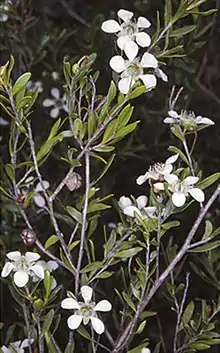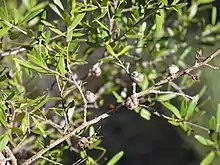Leptospermum sejunctum
Leptospermum sejunctum is a shrub that is endemic to the Nowra district in New South Wales. It has thin, grey bark, lance-shaped to elliptical leaves, white flowers and fruit that remain on the plant at maturity.
| Leptospermum sejunctum | |
|---|---|
 | |
| Near Bomaderry | |
| Scientific classification | |
| Kingdom: | Plantae |
| Clade: | Tracheophytes |
| Clade: | Angiosperms |
| Clade: | Eudicots |
| Clade: | Rosids |
| Order: | Myrtales |
| Family: | Myrtaceae |
| Genus: | Leptospermum |
| Species: | L. sejunctum |
| Binomial name | |
| Leptospermum sejunctum | |

Description
Leptospermum sejunctum is a shrub that typically grows to a height 1–1.5 m (3 ft 3 in–4 ft 11 in). It has thin, grey bark, the younger stems more or less glabrous with a conspicuous flange. The leaves are elliptical to lance-shaped with the narrower end towards the base, 10–20 mm (0.39–0.79 in) long and 3–4 mm (0.12–0.16 in) wide with a blunt tip and tapering at the base but without a petiole. The flowers are borne singly on short side shoots from adjacent leaf axils. There are pale reddish-brown bracts and the floral cup is glabrous, about 2 mm (0.079 in) long. The sepals are broadly egg-shaped, about 2 mm (0.079 in) long and the stamens are about 2 mm (0.079 in) long. The fruit is a capsule about 8 mm (0.31 in) in diameter, the sepals having fallen off, and that remains on the plant when mature.[2][3]
Taxonomy and naming
Leptospermum sejunctum was first formally described in 1989 by Joy Thompson in the journal Telopea, based on plant material collected near Nowra in 1981.[3][4] The species is named for its location, separate from the somewhat similar L. variabile and L. oreophilum.[3]
References
- "Leptospermum sejunctum". Australian Plant Census. Retrieved 26 May 2020.
- "Leptospermum sejunctum". PlantNET - New South Wales Flora Online. Royal Botanic Gardens & Domain Trust, Sydney Australia. Retrieved 30 May 2020.
- Thompson, Joy (1989). "A revision of the genus Leptospermum (Myrtaceae)". Telopea. 3 (3): 407–408.
- "Leptospermum sejunctum". APNI. Retrieved 30 May 2020.